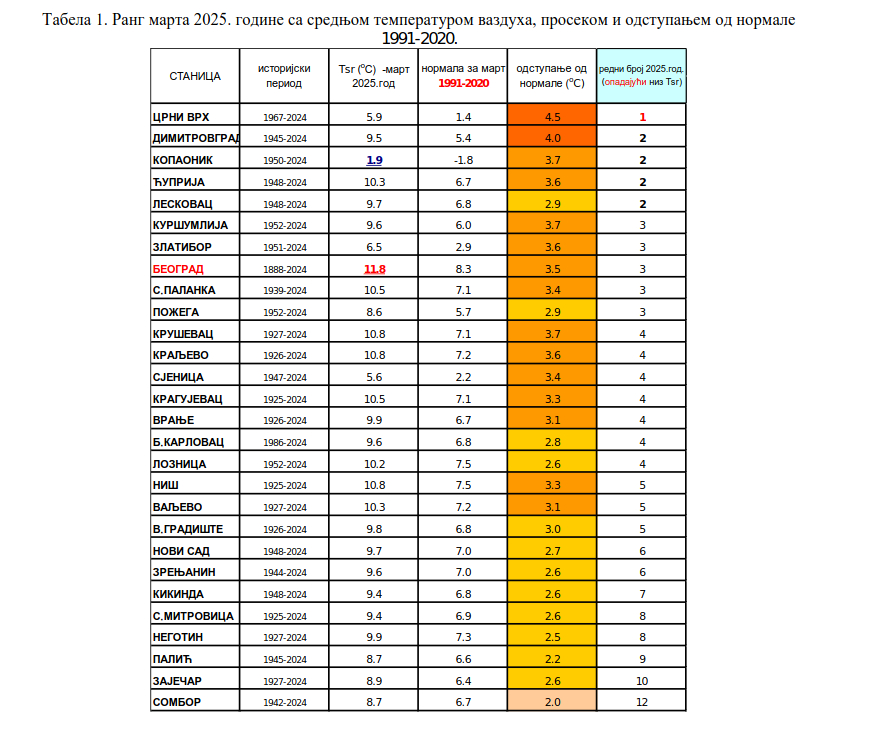The warmest March in Europe: What do RHMZ data show for Serbia? – Climate change

March 2025. was the warmest March in Europe and the second warmest temperature of 14.06 degrees Celsius, which is 1.60 above the pre-contained average for that month, the European Climate Change Copernicus (Copernicus) said. In Serbia was the third warmest March since 1951. years.
Unusually high temperatures for March, they detoured the Iberian Peninsula and South France. The period was accompanied by « extreme and contrasting precipitation throughout Europe, » Samantha Burdžes told the European Center for Medium Time Forecast.
She added that many regions had the saddest Mart in history, while others had the most precipitation in almost 50 years.
Global temperatures have remained in a record in the planet in March on the planet, in accordance with scientific predictions related to global warming.
The March ’25 Climate Bulletin is out. It was the Warmest March on record for Europe and the Second-Warmest March Globally, with a Global Average Surface Air Temperature of 14.06 ° C, 1.60 ° C The Pre-Industrial Level for March. Read the Details https://t.co/d0k1cmwoby# C3s pic.twitter.com/gm8luoeimq
– Copernicus ECMWF (@CopernicusecMWF) April 8, 2025
In Serbia average temperature in March 9.2 degrees
According to the data of the Republic Hydrometeorological Institute (RHMZ), March was the third warmest in Serbia since 1951. year with a medium temperature of 9.2 degrees of Celsius, were only March 2024. year with a medium air temperature of 9.7 and March 2001. year with 9.6 ºC.
« On the black top, Mart was the warmest, with a mean air temperature of 5.9 ºC. Year with a medium temperature of air 5.6 ºC. In Dimitrovgrad, in Kopaonik, this March is the second most recent since the measurements at these stations, while in the larger part of the country March 2025. years among the hottest in the history of measurement « , Informs RHMZ in a monthly newsletter.
Medium air temperatures ranged at an interval of 8.6 in Požega to 11, 8 degrees in Belgrade, while in mountain areas they were 1.9 on Kopaonik to 6.6 on Zlatibor.
« Deviation of Middle Moon Air Temperature from Normal for the reference period in Sombor to +4.5 ºC on the black top. There was very warm and extremely warm in most of the country, while in Sombor, Novi Sad, Zrenjanin, Kikinda and Zajecar, » explain from RHMZ.

The mean maximum air temperature is the highest ever recorded on the black top, in Ćuprija and Dimitrovgrad.
The highest maximum daily temperature in Serbia was 30.0 ºC 15. March in Kruševacwhich is only 1952 in this station. years. In Belgrade, it is 15. Marta measured the highest air temperature of 24.3 ºC.
As he states RHMZ, during March, he was recorded one heat wave At all meteorological cells except Loznica, and lasted from the middle of the first to the middle of the second decade of March at most stations. The longest wave lasted 12 days on the black top, in Vranje and Dimitrovgrad.
The middle minimum temperature ranged from 1.8 in Zajecar to 7.5 in Belgrade, on the mountains of – 1 on Kopaonik to 2.8 on Zlatibor. The highest highest minimum temperature has been recorded on the highest minimum temperature since measurements and amounted to 2, 7 degrees. Also, a record number of frosty days on the black top and Kopaonik was recorded.
The lowest minimum daily temperature was measured 18. March on Kopaonik and was – 13 degrees, while in lower areas the lowest daily temperature was registered in Zajecar – 8, while in Belgrade, there were – 2.9 degrees in Belgrade.
The most beautiful March on the black top
When it comes to precipitation, it was the ninth most beautiful March in Serbia since 1951. years. Years.
« The recorded amount of precipitation during March was in the interval of 29.4 mm in Zajecar, 64.8 mm registered in the total amount of precipitation in 1991-2020. Was of 65% in Zajecar to 244% in Sombor, » listed from RHMZ.
The most beautiful March was on the black top, and the absolute daily maximum amount of precipitation was registered with Kopaonik 28. March, when 47.9 mm precipitation, which was overcome by the previous record of 31. March 1967. year when 47.0 mm precipitation was recorded. The largest daily amount of precipitation in Belgrade was measured 27. Marta and was 22.7 mm.
Follow us on our Facebook and Instagram page, but also on X account. Subscribe to PDF List release today.








